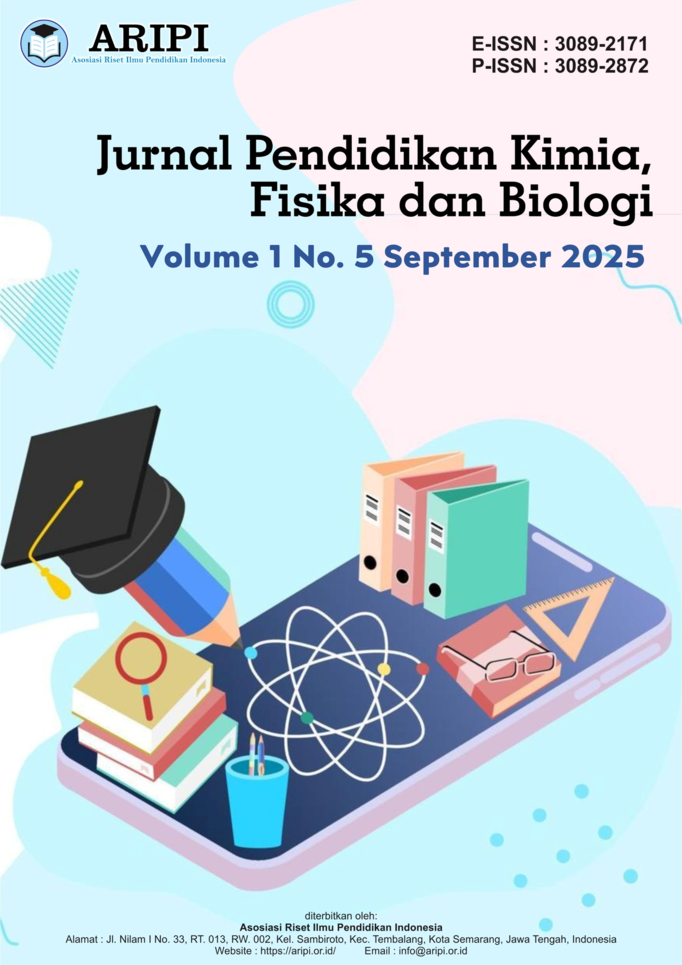Analisis Kualitas Air Limbah Domestik Berdasarkan Parameter pH, Amonia, dan Chemical Oxygen Demand (COD) untuk Evaluasi Lingkungan
DOI:
https://doi.org/10.61132/jupenkifb.v1i5.640Keywords:
Ammonia, COD, Domestic wastewater, pH, SpectrophotometryAbstract
This study aims to analyze the quality of domestic wastewater based on three main parameters: pH, ammonia, and Chemical Oxygen Demand (COD). The wastewater samples were collected from an industrial area, chosen for its role as a primary source of domestic waste that can impact environmental quality. The pH was tested using potentiometry, while ammonia and COD concentrations were measured using UV-Vis spectrophotometry, a precise method for analyzing these substances. The results showed that the pH values of the wastewater ranged from 6.68 to 10.28. This variation in pH reflects the acidity or alkalinity of the wastewater, with some samples being neutral to slightly alkaline. The ammonia levels detected ranged from 0.0654 to 0.3849 mg/L. While these levels are within the limits set by regulations, they indicate a significant presence of ammonia in the wastewater, which requires continued monitoring. However, the most striking finding was the COD levels, which ranged from 21.60 to 245.71 mg/L, with some samples showing very high values. High COD levels indicate a large presence of organic matter, which can lead to a decline in water quality. Some samples with COD values exceeding the threshold of domestic wastewater quality standards, as stated in Ministerial Regulation No. 68 of 2016, require additional treatment to reduce organic contamination. Overall, while the pH and ammonia values remain within safe limits, the high COD levels in some samples indicate that further treatment is necessary to reduce organic pollution. This study emphasizes the importance of routine monitoring of domestic wastewater to protect environmental quality and prevent broader negative impacts on aquatic ecosystems and human health.
References
Abu Shmeis, R. M. (2018). Water chemistry and microbiology. Comprehensive Analytical Chemistry, 81, 1-56. https://doi.org/10.1016/bs.coac.2018.02.001
Aniriani, G. W., Putri, M. S. A., & Nengseh, T. (2022). Efektivitas penambahan moving bed biofilm reactor (MBBR) terhadap kualitas air limbah di instalasi pengolahan air limbah Pondok Pesantren Mahasiswa Universitas Islam Lamongan. Jurnal Ilmiah Sains, 22(1), 67. https://doi.org/10.35799/jis.v22i1.35562
Azizah, M., Humairoh, M., & Mira, D. (2015). Analisis kadar amonia (NH3) dalam air sungai Cileungsi. Vol. 15.
Badan Standarisasi Nasional. (2005). SNI 06-6989.30-2005 tentang air dan air limbah - Bagian 30: Cara uji kadar amonia dengan spektrofotometer secara fenat.
Badan Standarisasi Nasional. (2019a). SNI 6989.2:2019 tentang air dan air limbah - Bagian 2: Cara uji kebutuhan oksigen kimiawi (COD) dengan refluks tertutup secara spektrofotometri. BSN: Jakarta.
Badan Standarisasi Nasional. (2019b). SNI 6989.11:2019 tentang air dan air limbah - Bagian 11: Cara uji derajat keasaman (pH) dengan menggunakan pH meter.
Butler, D., Friedler, E., Almeida, M. C., Butler, D., & Friedler, E. (1999). Article in Urban Water. www.elsevier.com/locate/urbwat
Camargo, J. A., & Alonso, Á. (2006). Ecological and toxicological effects of inorganic nitrogen pollution in aquatic ecosystems: A global assessment. Environment International, 32(6), 831-849. https://doi.org/10.1016/j.envint.2006.05.002
Damayanti, I. F., Hapsari, A., Al-Irsyad, M., & Supriyadi, S. (2024). Analisis kualitas limbah cair berdasarkan perbedaan waktu operasional (Studi kasus Hotel X). Sport Science and Health, 6(6), 583-598. https://doi.org/10.17977/um062v6i62024p583-598
Li, Y., Guo, A. J., & Zhou, J. (2011). Study of treating high ammonia-N domestic wastewater with CASS process. Procedia Environmental Sciences, 11(PART B), 858-863. https://doi.org/10.1016/J.PROENV.2011.12.131
Moretti, A., Ivan, H. L., & Skvaril, J. (2024). A review of the state-of-the-art wastewater quality characterization and measurement technologies. Is the shift to real-time monitoring nowadays feasible? Journal of Water Process Engineering, 60, 105061. https://doi.org/10.1016/J.JWPE.2024.105061
Nur Indryastuti, D., Iryani, A., & Fathurrahman, M. (2022). Comparison of analysis results of pH, TSS, COD and ammonia in industry wastewater with sparing and SNI methods. HELIUM: Journal of Science and Applied Chemistry, 02, 53-57. https://doi.org/10.33751/helium.v2i2.6342
Sulistia, S., Cahaya Septisya, A., Teknologi Lingkungan -BPPT, & Program Studi Analisis Kimia Sekolah Vokasi, P. (2019). Analisis kualitas air limbah domestik perkantoran. Jurnal Riset Lingkungan, 12(1), 41-57. https://doi.org/10.29122/jrl.v12i1.3658
UN-Water Publications. (2021). Summary Progress Update 2021: SDG 6 - water and sanitation for all. https://www.unwater.org/publications/summary-progress-update-2021-sdg-6-water-and-sanitation-all
U.S. Environmental Protection Agency. (2013). Aquatic life ambient water quality criteria for ammonia - Freshwater. https://www.epa.gov/wqc/aquatic-life-criteria-ammonia
Downloads
Published
How to Cite
Issue
Section
License
Copyright (c) 2025 Jurnal Pendidikan Kimia, Fisika dan Biologi

This work is licensed under a Creative Commons Attribution-ShareAlike 4.0 International License.





